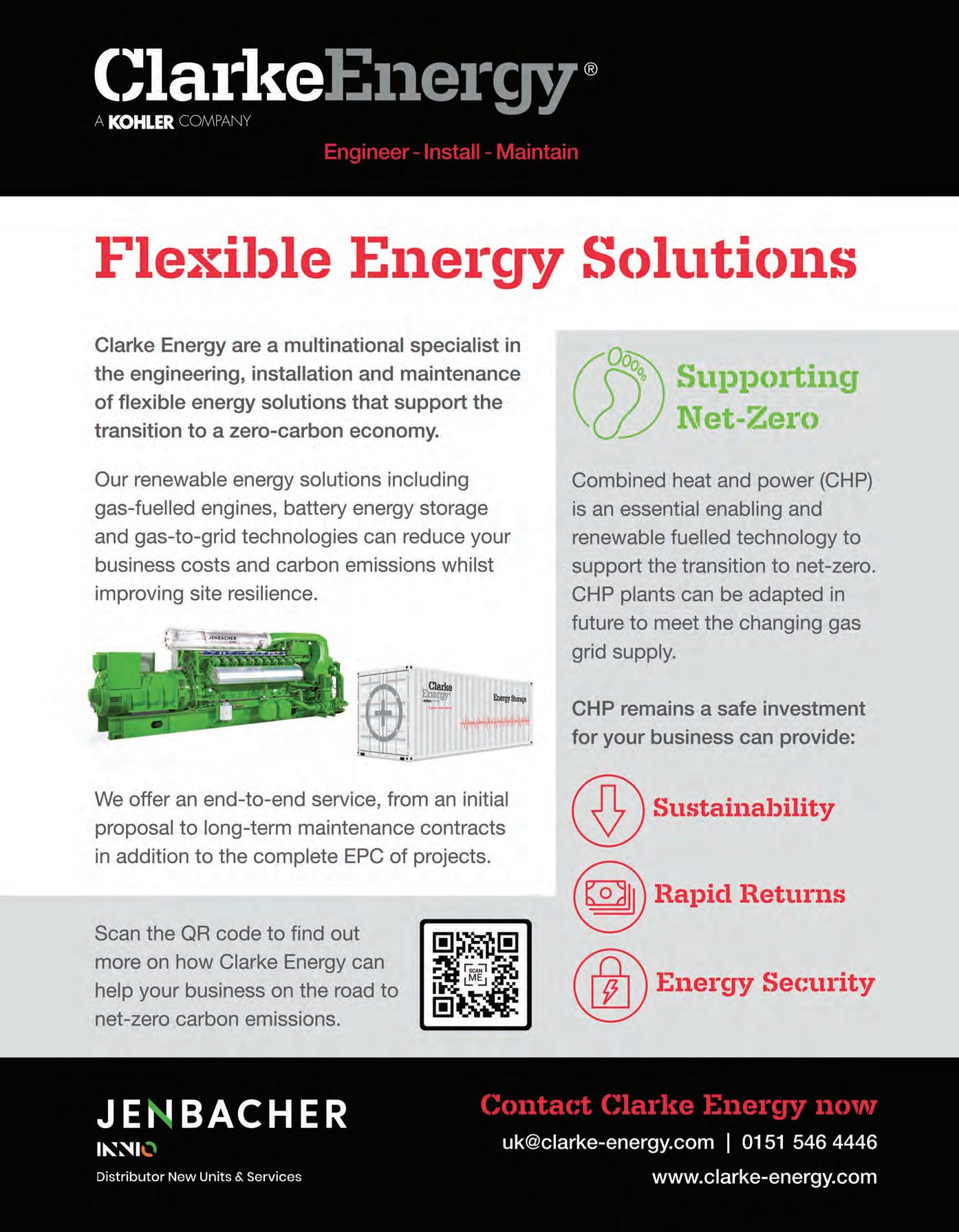
17 minute read
Combined Heat & Power & District Heating
Ian Bradley is managing director at
Modutherm
Advertisement
t’s probably safe to say that ancient
IGreek philosophers are rarely quoted in the building services media. But one such philosopher, who went by the name of Heraclitus, actually captured how it feels to be in the industry these days: “Change is the only constant in life.” He’s not wrong. It seems like every day there’s a new acronym or advisory to pay attention to – especially in the pioneering world of heat networks.
Of course, the driving force behind all this change is the concerted move away from fossil fuels and decarbonisation. Combined with the inexorable energy price rises over the last year or two, the industry has experienced an increased demand for heat pump-based heat networks.
Since the third generation of heat networks in the 1970s, we’ve moved to the fourth generation – which use renewables like heat pumps and other electrification to maximise output and minimise harmful emissions. The exponential growth of heat networks that integrate heat pumps has changed the regulatory framework.
This ensures the latter are designed to maximise the latest technological developments and manufacturers’ ingenuity in combining ever more efficient appliances with renewables.
We have seen this with the revision to CIBSE’s Guide to Heat
Networks (CP1 2020). As you would expect, the emphasis currently is on operating heat networks that utilise heat interface units (HIUs) at low temperatures. As a result, manufacturers are creating advanced HIUs and this is where annual volume weighted average return temperature (VWART) becomes so crucial; equally it is important for specifiers and heating engineers to get to grips with when designing heat pump-based heat networks.
Modutherm’s Alira HTS heat pump is available in four models with heating capacity up to 98kW

The return is king
As heat networks continue to rise in popularity it’s important for specifiers to understand the importance of annual Volume Weighted Average Return Temperature (VWART), writes Ian Bradley
Standard benchmarks
Back in 2016, BESA (British Engineering Services Association) launched a UK Standard for Heat Interface Units, which had been developed in collaboration with industry experts.
The BESA standard benchmarks HIU performance and verifies it against a set of tests that replicate typical UK operating conditions. A key factor of the test is VWART, which is an amalgamation of estimations of the annual VWARTs for domestic hot water, space heating and keep-warm functions.
Modutherm’s MTA PLUS TWIN heat interface unit is claimed to be the most efficient on the market
The BESA testing has been an important step towards improving the performance of UK district heating schemes. By measuring the performance data of different HIUs within the context of typical UK operating conditions, it becomes valuable in enabling heating engineers and heat network system designers to consider the performance of specific HIUs – not only against design requirements but also the many competing manufacturers.
In simple terms, VWART measures return temperature, which is one of the best ways to consider a heat network’s efficiency. A lower return temperature results in a larger delta T, which means lower flow rates are required to achieve the same kW delivery. In practice, this allows smaller pumps and pipes to be used - and smaller pumps mean lower capital expenditure and power consumption. Smaller pipework also reduces surface area and related heat losses.
To conclude, specifying equipment that delivers low VWARTs is the best approach to improving the efficiency of a heat pump led heat network, remembering, of course, that, the CIBSE Code of Practice states, as a minimum requirement, the VWART should be no higher than 33°C.
Designing heat networks
Here at Modutherm, we’re very happy that our MTA PLUS TWIN HIU recently achieved top marks in registering the lowest VWART in both the high and low temperature tests of any heat interface unit, with values of 26 and 24 respectively. That’s better than any other HIU previously tested. We can claim that our HIU is the most efficient on the market.
There are multiple ways of designing heat networks, depending on the needs of any given situation, and a myriad of variables that contribute to the best performance of each system. By using VWART, consultants are able to specify the most efficient HIUs – especially when they are combined with matching heat pumps.
This gives engineers and specifiers the ability to create incredibly energy efficient heat networks that deliver generous amounts of heating and DHW to a building’s occupants. And they do all of this while contributing to decarbonisation goals, reduction in harmful emissions and the wider use of renewables.
The team at Modutherm is always searching for ever more efficient and innovative ways to build heat networks. It’s our ambition to be the very best at what we do, which brings us neatly back to that ancient Greek thinker again, who also once wrote: “Big results require big ambitions.”
In the coming years the fifth generation of heat networks will see networks include perhaps cooling – using reverse cycles with heat pumps and keeping internal temperatures at a very comfortable level all year round.

Combined Heat & Power & District Heating
CHP installations contributing to the decarbonisation of Stoke-on-Trent
Three CHP installations are playing a key role in a major decarbonisation project in Stoke-on-Trent.
In 2017 the city council formed a collaboration with SIEMENS to develop a series of energy-saving projects as part of the council’s plans to cut carbon emissions, increase the use of renewable energy and reduce costs. As the lead technical partner, boosted by several local partnerships, Siemens entered discussions to investigate ways of improving the energy performance of the local authority’s buildings over a five-year period.
As part of its decarbonisation drive, the council secured £4.34m funding from the Department for Business, Energy and Industrial Strategy (BEIS) under the Public Sector Decarbonisation Scheme, delivered by Salix Finance. The scheme aims to put the public sector at the forefront of decarbonising buildings in the UK.
The first phase of the programme involved a widescale LED lighting upgrade. A total of 5,440 energyefficient LEDs were installed in many well-known locations in the city over nine months.
The three new CHP installations are at the Civic Centre, Dimensions Leisure Centre and at Fenton Manor Sports Complex. All will be operational by 2025 to generate electricity and steam for power and heat on-site, saving the council £250,000 per year.
In addition, solar PV installations supply power to Dimensions Leisure Centre and Fenton Manor Sports Complex, adding further to onsite power generation.
Air source heat pumps at Fenton Manor Sports Complex and New Horizons Leisure Centre also provide a lower-carbon way of heating the swimming pools and contribute further to decarbonisation. New pool pumps, filtration and control systems were added. Heat pumps and air handling units have also replaced panel heating at Steel House, an operational council-run building.
To help manage the new technologies, Siemens Desigo CC was deployed as an upgrade to the existing building management system which has improved the optimisation and efficient use of building services across the sites.
Councillor Carl Edwards, Stoke-onTrent City Council cabinet member for housing and the environment, said: “The decarbonisation works sit alongside innovative programmes such as the District Heat Network, where more than four kilometres of piping is already installed under roads in Stoke town with the aim of connecting properties up to more sustainable energy supplies.”
As well as its work with Stoke-onTrent City Council, Siemens has also supported other decarbonisation projects across Staffordshire. Its work with Keele University and its SEND project created Europe’s largest testbed for the research and development of renewable and smart energy technologies. Through SEND, energy generation, distribution, storage, forecasting and energy balancing implementations are being learned in a ‘living laboratory’ to help achieve cost and carbon savings for the university.

Care home’s new combined heat & power unit slashes electricity bills
HELEC LIMITED, an M&E specialist in the specification, design and installation of combined heat and power systems in pre-packaged plant room solutions, has supplied and commissioned an Energimizer EM16NG CHP unit to Barchester Healthcare’s Snowdrop Place care home in Botley, Southampton.
Helec was tasked with this project in December 2019, when it worked with the main M&E contractors’ consultant Mark Comerford to optimise the hydraulic layout. Work started in May 2020, when the CHP unit was delivered to site, but the pandemic delayed the build, so it was eventually commissioned in December 2020. Helec supplied and commissioned the CHP in the plant room on behalf of a contractor.
As this is an upper floor plant room, the CHP had to be extra quiet with its running noise. The acoustic insulation provides a sound pressure level (SPL) for this CHP at 46 dB(A), measured at 1m distance - quieter than an American-style double door fridge. Snowdrop Place expects to save around 104,000kWh of electricity per year, which could reduce the care home’s electricity bill by as much as £15,600 per year.
Jonathan Passmore, UK technical sales manager at Helec Ltd, said: “We were delighted to support the site installation team in order to deliver this efficient 16kWe CHP unit which will contribute well to help reduce the running costs at Snowdrop Place.”
Run by Barchester Healthcare, Snowdrop Place is designed specifically to support people living with dementia and those who require residential care.


Electricity Supply Options
Tom Abbott is head of PPA at EDF

Choosing an electricity supply option that is backed by zero carbon sources can be a quick and simple way to improve your sustainability credentials
Choose the right power option
How can you use your electricity supply to support your sustainability goals? Tom Abbott outlines some of the options available to businesses and the associated benefits
ith such an unstable
Wmacro environment resulting in an increasingly complex energy landscape, juggling prices while continuing to meet your environmental targets is a challenge right now.
But it’s important that we don’t let this veer us away from reaching net zero. So, business should take control of their energy; choosing the right electricity supply option, that aligns with their organisation’s priorities and enables them to achieve their sustainability goals.
Especially in the current market, it’s essential for businesses to plan and budget their energy spend. Understanding your energy needs and consumption patterns can help you significantly reduce your environmental impact and by taking control of your energy you can unlock bottom-line value for your business. A considered approach to how your business is using energy enables you to save both money and carbon.
What is the right option for my business? Well, that depends on your business’ goals, capabilities and risk mandate. Let’s look at some of the options available to help you understand which approach may be best for your business.
Choosing an electricity supply option that is backed by zero carbon sources can be a quick and simple way to improve your sustainability credentials and requires minimal investment. It is a great first step on the journey to net zero and would see your energy supply made up from a number of different zero carbon sources, backed by a mix of nuclear and renewables which are evidenced by certificates known as Generation Declarations (for nuclear) and REGOs (for renewables). This offers a good sustainability message to your customers, suppliers and investors as it enables you to report zero marketbased emissions under the GHG Protocol Scope 2 reporting guidelines.
You may also choose to power your business through 100 per cent renewable electricity. There are a range of options available here, ranging in specificity. From powering your business through any form of REGO backed supply, to options that offer the ability to specify a particular source, such a wind or solar power. You can even choose a contract that links you to a specific, named renewable generation asset, this allows traceability and gives you an even stronger sustainability message for your investors and suppliers. This variety of options, backed by renewable certificates, again enable you to report zero carbon emissions, and are relatively simple to put in place.
Make a difference to the grid
For larger energy consumers who can make a longer-term commitment, a Corporate PPA (CPPA) could be an interesting option. When you start to look at CPPAs, things start to get more complicated to put in place but you’re also starting to make a real difference to the energy grid and decarbonisation.
A CPPA is a direct contractual agreement between a business and a renewable energy generator, to build a new renewable asset. In a CPPA you would usually agree to pay a fixed price for all of the generation from that asset over a 10-15 year term,
providing long-term cost certainty.
This then enables the generator to make a final investment decision and bring that new renewable asset onto the grid. Your power would still come via the grid (there’s no physical connection), but you are contracting with a named generator, enabling you to say that your energy is coming from a specific source.
This creates a strong sustainability message and is a huge commitment to net zero, as without that contractual agreement put in place, that renewable power wouldn’t have come onto the grid; true ‘additionality’. The challenge with a CPPA is the complexity, as they are much more involved to set up and manage, so you need the resources to make it work, and that’s where an experienced and trusted partner is important to help you make it happen.
Renewable generation onsite
Another consideration is onsite generation. Rather than sign an agreement to buy power from elsewhere, your business could install renewable generation onsite, usually solar panels on top of a roof or on unused land space. This option again offers you true additionally by bringing new renewable generation onto the grid and again, creates a great sustainability story for your customers, investors and suppliers.
There can be upfront costs involved, but there are options for financing without the need for capital outlay and the benefits case for onsite solar has never been stronger given current high power prices. It’s a great way of reducing complexity and can reduce energy bills, removing third party delivery costs. Investing in decentralised opportunities, like onsite generation, can also increase resilience, as you reduce your dependence on the grid and are protected from market price volatility.
Every business is different. And it’s essential that you have a supply contract structure that suits you.
The energy market is complex, but experience tells us that businesses make better decisions when they’re better informed. Working with a reputable supply partner will help you devise and execute an energy strategy to meet the short and long term needs of your business.
At EDF, we can help you navigate these options and guide you to balance your budgetary and sustainability goals. ● Get in touch with us at
letstalkpower@edfenergy.com
Combined Heat & Power & District Heating
Heat pump system provides hot water and CO2 to aid cucumber growth
CLARKE ENERGY has recently delivered a hybrid energy system to power one of the largest glasshouses in the UK that has been developed by renewable energy company, AGR.
The 217,000m² glasshouse site combines a 33MWth heat pump system with a 9MWe CHP plant with CO₂ recovery. The installation of heat pumps provides renewable hot water heating to the site and the CO₂ recovered from exhaust gases is transferred to the glasshouse to help accelerate the growth of the produce. The glasshouse will grow 10 per cent of cucumbers consumed in Britain and uses 30 per cent less CO₂ than conventionally heated glasshouses.
The Energy Centre for the glasshouse combines a 33MWth heat pump system with a combined heat and power (CHP) plant comprising three high-efficiency INNIO Jenbacher gas engines with CO₂ recovery. The installation of heat pumps provides renewable hot water heating to the glasshouse and will qualify for the Renewable Heat Incentive (RHI). IES Energy, a heat pump manufacturer, has supplied and installed the heat pumps for the project. The company’s partner, Pure Renewables, has designed and installed the open-loop collection system which runs over a distance of 750m. Clarke Energy and AGR opted for an ammonia (R717) refrigerant system as opposed to a hydrocarbon refrigerant from IES Energy as ammonia has a higher efficiency value and global warming potential of zero.
The liquid-to-water heat pumps recover renewable heat from local reservoirs on site via the reverse Carnot cycle and through the use of an ammonia refrigerant. The openloop collection system involves eighteen pumps floating on platforms spread across the three reservoirs which extract water and transfer any available heat to the ammonia refrigerant (approx. 10°C). The heated ammonia is pumped to the seven compressors located near the glasshouse where the ammonia is compressed, and heat is transferred to the site thermal stores at circa 50°C. The compressors are split into three separate, skid mounted systems, one single compressor (4.7MW) and two twin compressors (9.5MW), powered in part by the Jenbacher engines.
The CHP plant comprises Jenbacher J416, J620 & J624 engines providing an electrical output of 9MWe, which are used to power the glasshouse, the LED grow lights and various site auxiliaries. Waste heat generated from the engines will produce hot water which will be stored in two 6,000m³ thermal stores and used to heat the glasshouses.


Hertfordshire school replaces ageing boilers with combined heat and power
Aldenham School in Elstree, Hertfordshire, has reduced energy demand, carbon and electricity bills at one of its boarding houses, while improving comfort levels, with the installation of a BAXICHP system.
When the ageing boilers serving Paull’s House reached end of life, the school was keen to explore replacement solutions to improve its green credentials. However, complex retrofit challenges in the draughty 16th century building meant that use of renewable heating technologies already had been ruled out.
The school’s main requirements were to ensure an efficient heating and hot water service for the boarders, connect the system to the neighbouring science block, and complete the work within the summer shutdown period. Reliability was also key as neither Paull’s House nor the science facilities could be without hot water.
“We were working with an extremely old, hard-to-heat building in which parts of the fabric date back to 1597,” explained Tony Albon, the school’s head of estates. “So, we decided to call in the heat experts for advice.”
A successful partnership was formed with heating manufacturers Baxi Commercial Solutions. Albon and Karl Mahon, Aldenham’s bursar, held lengthy discussions with the Baxi Commercial Solutions team who carried out multiple site visits to understand the exact requirements before presenting all the feasible options.
“It was clear that the most viable solution to meet all our needs was a combined heat and power (CHP) and condensing boiler system,” Albon continued. “Not only can this solution meet the heating and large domestic hot water requirements more efficiently at Paull’s House, reducing energy demand, but it produces electricity at lower costs for use within the building.”
A Remeha R-Gen SenerTec Dachs G5.5 CHP was selected, supported by three Potterton Commercial Sirius three 110kW wall hung condensing boilers. The project contractors were Keeble Environment Services.
Both the CHP unit and the ultralow NOx, stainless-steel boilers are compatible with the proposed introduction of 20 per cent hydrogen into the gas network, enhancing the sustainability of the installation.
“The collaboration has resulted in the best possible solution for the School, meeting all our objectives,” Albon added. “The CHP team has been by our side throughout the project. They also brought in their technical, training and commissioning experts to support us and the contractor and will be carrying out all future maintenance and servicing.
“Our boarding students have commented on the improved comfort levels in Paull’s House, as have the teachers in the science block,” he continued.
“We also anticipate an annual reduction in electricity bills of around £3,500 and a saving of over 6,000 kg of carbon from the CHP. It’s a fantastic result – we have great plans for further projects with this partnership.”



